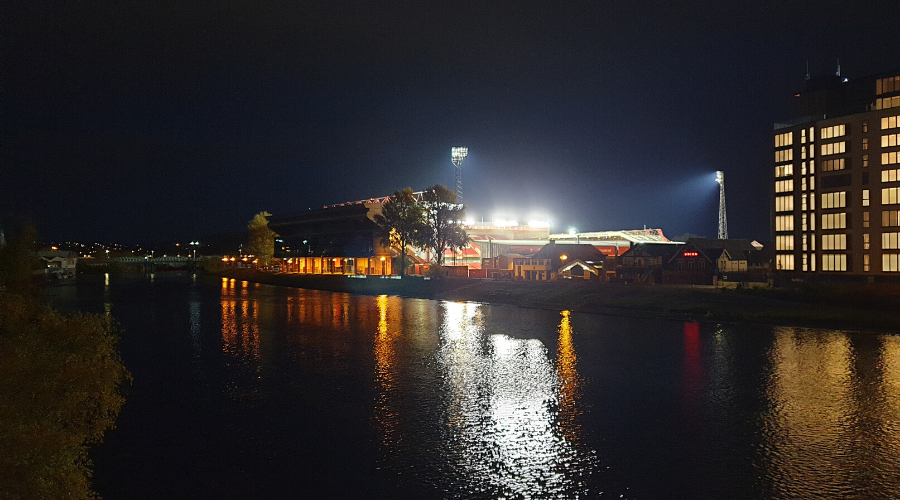While thousands of football fans are made to make do with coverage broadcast to their living rooms courtesy of Sky Sports and BT Sport, or possibly even a rogue stream found online with bonkers Spanish commentary, a privileged few have been given access to matches behind-closed-doors throughout lockdown.
Eerie. When asked how it felt the first time I stepped foot into an empty stadium, knowing that I wasn’t just arriving early ahead of the barrage of dedicated supporters, the only word I could muster was eerie.
As the United Kingdom battled with coronavirus, football was one of the first things to be put on hold. The pause button had been pressed – for some, those in League One and League Two, it preceded an inevitable press of the stop button.
But for clubs in the top two tiers of football play resumed, allowing clubs the chance to fight for promotion and attempt to beat relegation.
The past few months, from a personal perspective as a freelance sports journalist, has been an incredibly strange and challenging time when covering Nottingham Forest.
A packed out City Ground’s atmosphere provides the energy to the players. It motivates them when struggling, provides the encouragement to seek a winning goal and intimidates the opposition from scoring.
Yet, since July, Forest have – along with several other clubs up and down the country – been forced to hold matches behind closed doors.
One of the biggest things I miss about a matchday at the City Ground is the friendly faces around the stadium. Whether it be the local Reds fans serving up food-to-go on Pavilion Road, to the stewards greeting me on my entry to the historic ground.
What would ordinarily be a straightforward route to the press box I now must fill in a questionnaire asking whether I have shown any symptoms in the last 14 days and whether I have been tested for coronavirus. After carefully filling in the form, a temperature check follows before being handed my accreditation pass and shown where to go to reach the press box.
At the start of last season I would take time to connect with the journalists around me. I’d discuss all things Forest with George Harbey of Football League World, and catch a brief chat with Paul Taylor (The Athletic) and Sarah Clapson (Nottingham Post).

Nowadays though, none of that is possible. The regular local and national journalists have seats reserved for them in the press box, the rest of us must rest laptops or notepads on our knees from one seat in an array of chairs marked with green ticks each separated by six feet – thankfully I brought my extension lead to provide some last-minute energy to my trusty equipment.
One positive to come from being shuffled a few rows down the Peter Taylor stand is a wider range of view when attempting to follow the action. Previously the old stand’s dipping roof would provide a letterbox-style view of the pitch. From just a few feet down, however, you can see all off the pitch with great clarity, and even spot the occasional steward go and collect a clearance that has been sent into the upper tier of the Brian Clough stand.
In terms of the actual 90 minute match, very little has changed due to coronavirus. Where we may previously have leant over to a colleague from another publication to check a minor detail missed ourselves, instead we have to shout from a distance to get their attention – and then hopefully they’ll respond in similar fashion.

Credit: Matt Lee
One major plus point of hosting football with no spectators is the ability to hear, word for word, the instructions of managers or reactions of players.
My first visit to the City Ground this season, a 2-1 loss to Bristol City, proved to be the final straw for Frenchman Sabri Lamouchi. Throughout the game I could hear, despite being several hundreds of yards away, every word he said. “Press, press, press” he would bellow in the wonderful accent of his home country.
Since then, former Brighton & Hove Albion and Newcastle United boss Chris Hughton has taken over, and one thing I immediately noticed was his man-management capabilities. Where his predecessor would bark demands, Hughton takes a more relaxed approach – often providing infrequent comments of encouragement and suggestion.
The final thing that has changed for sports reporters is how post match media duties would take place. The stereotypical image of the football media is a crowd of journalists standing shoulder to shoulder, arms outstretched, less than a foot from the manager as they try to get their question in.

Nowadays, however, journalists are split into separate groups in order to break up how many people are nearby at any one stage. First are the duties with the broadcasters – in this instance Sky Sports and BBC Radio Nottingham – and then follow the opportunity for reporters such as myself, Sarah Clapston and Paul Taylor to ask questions.
It is by no mean an ideal situation, but the world is living in a very difficult time. Football without fans is nothing, but this is not something we can rush into. I for one cannot wait to see spectators flock over Trent Bridge and hear the ticking of turnstiles clocking over as fans enter the ground. Only, however, should this be done when it is safe to do so – until then, journalists such as myself, and supporters, must make do with this new lifestyle.
I assure you though, fans will be back and, when that day comes, it will be a spectacular feeling.
By Matt Lee

